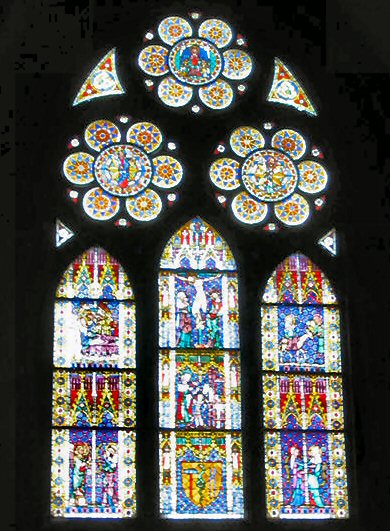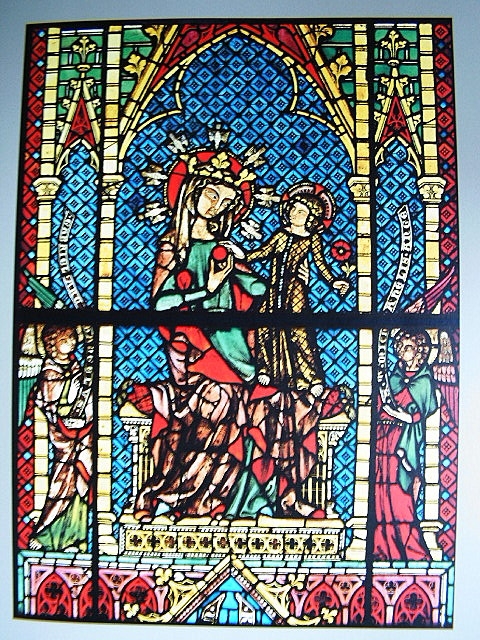
Reserved Area
Artists - ArtWorks
Freiburger Cathedral Glass Windows
 Germany
GermanyCenterpiece of the so-called „painters-window“ of Freiburg cathedral, that was made about 1320/30. It is about three tracery-free lance-shaped window sections beneath a pointed arch.
Short before the nave and the tower of Freiburg cathedral and the stained glass windows of the already in 1230 and 1280 complished nave were completed, this was realised by the sponsoring of the different craft-guilds and some rich townsmen. Therefore an unique program of the glass-paintings motives doesn´t exist.
The same motive can also be found on the portal of the Freiburg cathedral.
The motive of this stained-glass window is very huge and shows the throne of Kind Salomonis. It is one of the first illustrations that reaches over more than one window section. Something of this kind can only be found at the Cologne cathedral in a similar way.
Church- or cathedral buildings couldn´t have been mede without sponsoring by clerical and mundane donators. A lot of artwork within cathedral-buildings therefore not only is expression of deep faith but also expression of wealthiness of the towns and parish.
As mentioned before the windows of the cathedral were donated by the guilds, and the symbols of the guilds are featured on them. The deep red color in some of the windows is not the result of a dye, but instead the result of a suspension of solid gold nanoparticles. These techniques are also known in non-clerical glass-artisanry.
Salomons throne consists of several steps that crown the “mother of god”.
In the middle of the lower chapter one can find a crucifixion-scene.
On the steps hollows are positioned, on the top level step just beneath Maria one can see a lioness that tries to reannimate her dead-born lion-puppies.
The steps of the throne are painted on the lateral windows, the central elements of the picture are placed on the window in the middle.
Gothic architecture is based on the idea of the so called celestial city (mentioned in the New Testament). This celestial Jerusalem is described as gorgeous city that replaces earthly world. Gothic cathedrals are an insight in this celestial city. Still more they can be seen as the entrance to paradise.
This imagination of a celestial city can not be seen without the experience of light that symbolises devine omnipotence. Compact masonry is replaced partly by huge window-areas, and therefore glasspainting receives a key-role in the artwork of a cathedral.
The stained-glass-windows show the former philosophy that light is the basis of all being. Glass typified the reflection of celestial Light in order to show devine wisdom.
By that stained-glass-windows there was created some kind of mystic darkness in the cathedrals interior. The spectators view was/is directed to the coloured glass areas beaming like gemstones.
The message of the stained-glass-windows emerged before printing was developed and focused on intuitive experience. Glass-painting was a mighty means in those times that can hardly be understood today. Gothic art never relied on a perfect form of architecture but always tended to include symbolic or even psychological contents. William Durand (in his oevre “The Symbolism of the churches of 1286”) mentioned: “ The stained-glass-windows in a church symbolise the holy bible that prevent wind and rain and that means: all things that represent pain. On the other hand they send the sunlight into believers heart. ….”
This stained glass window was chosen because the middle ages can be treated as a time of magnificient meaning of sacral buildings. Thereto belongs not only the builing itself, but also its “interior”
Stained-glass-windows in cathedral-buildings do not only fulfill a function of bringing light or restraining wind and rain. They belong to those means that alltogether form the so called "poor mans bible", artworks that transportet religious contents to people that couldn´t read and write.
Stained glass-paintings are not only interesting and very laborious from the technical point of view. They also allow an art-philosophical insight into the understanding of this era.
Becksmann, R. (1988). Deutsche Glasmalerei des Mittelalters. (german stained-glass-windows – a choice). Eine exemplarische Auswahl. Freiburg.
http://freiburgermuenster.info
http://www.fgs.snbh.schule-bw.de/see/muenster
http://en.wikipedia.org/wiki/Stained_glass
http://en.wikipedia.org/wiki/Poor_Man%27s_Bible
http://en.wikipedia.org/wiki/Poor_Man%27s_Bible#Stained_glass
Related Material:
Image available

File name: 113_Freiburger-Muenster-Fenster-2.jpg
Description of the material:
one of the stained-glass-windows of the Freiburg Cathedral
Contextualisation Of the source:
windows of this kind (stained-glass) were often ordered and payed by craftsmen. Thus most of the windows show which kind of crfat gild the sponsor belonged to.

File name: 113_Glasfenster-Freiburger-Muenster-1.JPG
Comments about this Artist/ArtWork
Michelangelo - Copyright 2008 - This project has been funded with support from the European Commission